ENVISION PhD Students Use the Science of Breadmaking to Attract Franklin Eighth Graders to STEM
You pull a couple of slices of bread out of the bag. You slather them with peanut butter and jelly, or construct a BLT, then take a big bite. But did you ever wonder how flour is transformed from loose powder to semi-structured slices that can hold sandwich fixin’s? Exactly what is the science behind breadmaking?
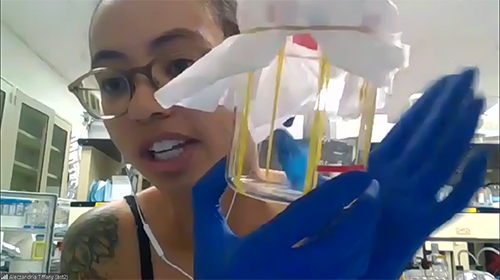
Alec Tiffany demonstrates to Franklin students how to begin their sourdough starter.
November 20, 2020
During fall 2020, four Illinois engineering PhD students, Emil Annevelink, James Carpenter, Drew Kuhn, and Aleczandria Tiffany, did a Zoom outreach at Franklin STEAM Academy, a Champaign middle school whose focus is on STEAM (Science, Technology, Engineering, Arts, and Mathematics). The goal behind the October and November virtual visits was to impart the science behind breadmaking to Katie Lessaris’ eighth grade science classes. Members of ENVISION (ENgineers Volunteering In STEM EducatION), a Registered Student Organization whose sole purpose is to provide opportunities for engineering grad students to do STEM outreach, the PhD students sought to not just communicate science, but to share how they ended up in engineering, serve as role models in that they too had overcome challenges, and to foster the middle schoolers’ interest in STEM. Of course, the fact that sourdough bubbles and smells added to the fun!
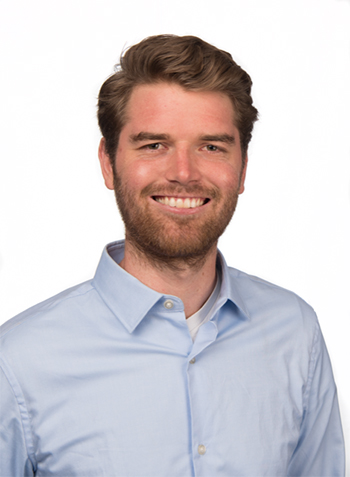
MechSE PhD student Emil Annevelink.
The grad students visited Lessaris’ various science classes via Zoom on Mondays, Wednesdays, and Fridays, during two separate two-week periods. There, they taught the history and science behind sourdough breadmaking, plus led the eighth graders in an experiment—each kid made their own batch of sourdough starter and got to experience for themselves not just the bubbling and the growth, but the smell. The experiment was connected to their science unit in that it helped students understand the difference between good and bad bacteria.
“We are starting to discuss how we, as humans, use and consume energy and what in our body breaks down these foods for energy,” Franklin’s science teacher, Lessaris, explains. “The GI microbiome is also a focus, so the sourdough experiment was a good visual for how bacteria can grow in its environment.”
So, why sourdough? Emil Annevelink, who’s working on a PhD in Mechanical Science and Engineering (MechSE), explains that because they were conducting virtual outreach, they “really wanted to focus on something that is accessible to students,” he explains. “Many of our outreach activities require specialized supplies and, even if they are inexpensive, having to go to the store to buy something can be enough of a barrier to prevent engagement. During our brainstorming, we thought that cultivating a yeast colony through making a sourdough starter would be both exciting and surprising to students, but still accessible.”
Knowing that making a sourdough starter would require only flour, water, and a container, they figured that, besides being inexpensive, those were things that most students would already have at home. “We hope that students learn about good/bad microbes (bacteria and yeast), that yeast has exponential growth, and about the scientific method,” he adds.
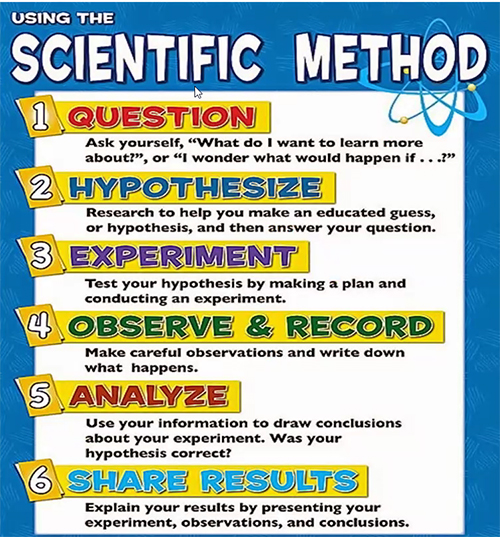
Scientific Method slide ENVISION members shared with Franklin students during a session.
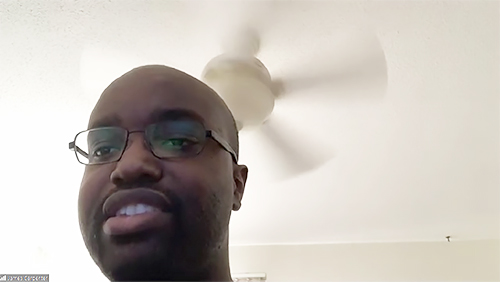
James Carpenter, a fourth-year MechSE Ph.D. student interacts with Franklin eighth graders during one of the Zoom sessions.
In addition to learning about the scientific method, Andrew Kuhn, a 5th year PhD student in Chemical and Biomolecular Engineering (ChBE), says another learning objective they sought to address was fermentation. “Organisms like yeast and bacteria are performing chemical reactions, but we cannot see them,” Kuhn explains, adding that they hoped to generally foster engagement and curiosity about science.
“The sourdough starter project is also a great introduction to scientific experiments,” continues Kuhn. “The procedure is simple; students can visually observe the changes (rising dough, smell, bubbles), and learning about bread-making is motivating and practical.”
Alec Tiffany, a 5th year ChBE PhD student agrees with her colleagues about doing an activity that used easily accessible materials since they couldn’t provide supplies due to working with students virtually. She acknowledges that because sourdough starter requires minimal ingredients (flour and water) and isn’t too involved to make, “It seemed like a perfect choice. Also, I think it's fun that the students could see and smell that their sourdough starter was working.”
Another goal of the outreach, besides communicating about science, was to share a bit about the grad students themselves, their research, and how they got interested in science and engineering. For instance, Tiffany, who designs biomaterials for bone repair in large bone injuries, shares how she got interested in her field.
“I was a very curious kid growing up and was always asking my parents questions they didn't have the answers to,” she acknowledges. Thus, they started buying her science books. As a result, she read about a ton of different topics—her favorite books being about oceans and volcanos. They also bought her science kits so she could make her own lip gloss or solve fake murder cases. “I thought science was so much fun that as I got older, I decided I wanted to be a scientist forever,” she admits.
James Carpenter, a fourth-year MechSE Ph.D. student with a concentration in thermal sciences, and whose research focuses on the design of functionalized, micro/nanostructured surfaces, also shared how he got interested in science and consequently ended up in engineering. For one, he liked being involved in science fairs “because you got to make decisions,” he says. Plus, he confesses that in middle school, while doing lots of tinkering at home, he got his worst grades in school. However, once he hit high school, he discovered that the things he was interested in—things like biology, catapults, circuits, designing, plus video games and how they work—tended towards science, particularly engineering.
“That’s what ultimately incentivized me to try to understand it better,” he acknowledges, adding that it comes naturally for very few people. “To be good at it, you have to work at it. Put time into it; that’s how you get good at it.”
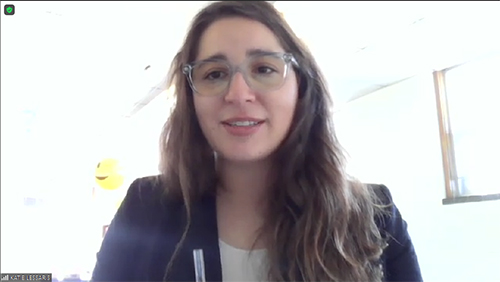
Katie Lessaris, Franklin STEAM Academy's eighth grade science teacher interacts with her students during the ENVISION PhD students' Zoom presentation.
Of course, one key advantage of the ENVISION-Franklin partnership is the opportunity eighth graders got to interact with the grad students, which Franklin’s Lessaris calls crucial in helping her students understand what opportunities lie ahead for them.
“My 8th graders are very curious,” she reports, “and it is sometimes hard to know what to be curious about. These opportunities pique their curiosities and give them a chance to ask questions and maybe find a path of study they enjoy.”
Lessaris also appreciates that her students got to see the human aspect of the University—the diversity and variety of students. Plus, while interacting with these students, her students learned that the older students had also encountered challenges and struggles, and not just success, in their education from middle school up.
“Sometimes University seems ‘out of reach’ for middle school students because subjects are challenging,” she states. “When they hear that these grad students have had similar experiences and feelings, it makes it more acceptable to have challenges and keep trying.”

Emil Anvelink interacts with Franklin students during on of ENVISION's sessions.
According to Annevelink, having PhD students like themselves interacting with middle school students is a win-win for both age groups. For instance, he claims it’s important that PhD students “interact with the community so that we can share our expertise and love of science with the community and learn how to communicate science more effectively.” But why middle school students? “Because research has shown that this is when they make decisions about what subjects they like or dislike,” he continues. “We hope that our outreach can give a more holistic perspective into going into STEM by sharing about our path, research, and working on an experiment with them.”
Kuhn adds that he thinks it’s also important that middle school students learn about careers in STEM “because many may not know exactly what we do,” he claims. “We encourage students to ask questions about science and engineering, but also we want to show them that we are ‘normal people.’ Being able to relate to the students through conversation and the experiments allows us to achieve our main goal: to encourage more students to pursue STEM fields or at least get exposure to them.”
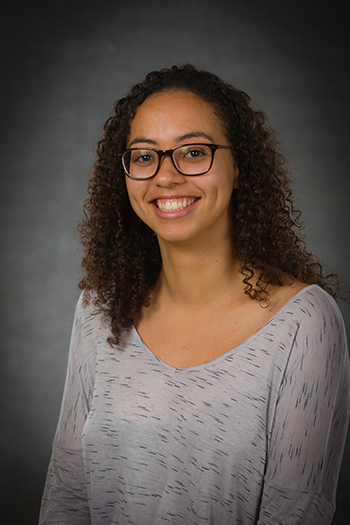
ChBE PhD student Alec Tiffany.
Tiffany sees eye to eye with Kuhn about conveying to students that scientists are real people. “It's important to show young students that scientists are normal people just like them and that science is cool/fun,” she agrees. “I watched a lot of Bill Nye the Science Guy when I was growing up, and it made science seem like something anybody can do (which is totally true!).” Reiterating what seemed to be one of the themes of the outreach, she adds: “I also love that we can express that we had to work hard and that becoming a scientist is something they can do too if they work hard and stay curious.”
Annevelink, who studies the mechanics of graphene, a 2D material, by developing dislocation-based models to control the structure and topography, shares why STEM outreach to middle schoolers is important: “I want to give everyone the opportunity to make an informed decision about going into STEM,” he explains. “I like ENVISION because the focus is on middle school when students are really forming opinions about if they like or dislike a particular subject. In addition, we try to engage in longer term outreach so that we can develop relationships with students and hear about what they like or don’t like about STEM.”
Kuhn, whose research involves the synthesis and characterization of nanomaterials for catalysis and sustainable energy solutions, got involved with the outreach because he is “passionate about teaching and explaining STEM topics through active learning. Hands-on science experiments are engaging and help inspire students to become scientists and engineers,” he explains.
Tiffany started volunteering with ENVISION because she wanted to give back to the community. “I love seeing people of all ages get excited about science,” she admits. “I was especially interested in this outreach event because we had multiple days to interact with the students, so we got to show them our personalities and discuss what we do and why we love science and engineering.”
Although ENVISION has traditionally done in-person, after-school programs, during the pandemic, its members have had to change many of their activities to adapt to online learning. However, Annevelink claims it’s been a positive experience. “Working with teachers during school is new for us but has been a good opportunity to utilize the expertise and skills of our local science teachers,” he admits.
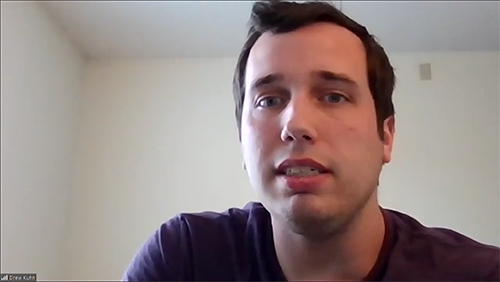
ChBE PhD student Andrew Kuhn shares with the Franklin students via Zoom.
Re the benefits of working with a local science teacher, Kuhn adds, “Ms. Lessaris was great to work with and helped our discussions go smoothly. Passionate and engaging educators like her make a big difference, especially in the online platform. She deserves a lot of credit for the success of this experiment.”
Echoing her cohorts’ appreciation for working with Lessaris at Franklin, Tiffany looks forward to their next outreach: “This was a really fun event to do, and I'm grateful we had the opportunity to interact with local science teachers and their classes. We are thinking of ways that we can build on this relationship and do another virtual experiment with the students next semester.”
In terms of the positive effect the outreach had on her students, Lessaris believes it’s had a huge impact. “I did not have these opportunities when I was younger,” she admits, “and I think now about all of the areas of study I wasn't aware of and probably would have enjoyed! This program shows students that reaching for the stars is possible and is not just a dream.” In addition, she acknowledges that the grad students did a great job of “being encouraging and supportive, which helps build the students’ confidence in a way a teacher may not be able to.”
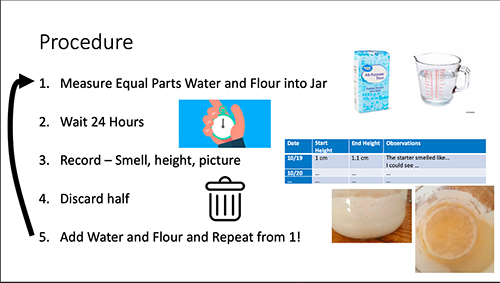
ENVISION team slide shows students the procedure they were to use to create their sourdough starter.
So, does Lessaris see some future engineers among her students that may have been set upon that career trajectory?
“Absolutely!” she acknowledges. “Each year I see those students that like to investigate, experiment with things, and ask questions about things that they didn't even know were engineering based! It excites me to think about the impact this connection with grad students may have for these young minds.”
Finally, she expresses her gratitude to the ENVISION members for taking time out of their schedules to interact with her students.
“I am beyond thankful for the efforts that Emil and his team have put towards teaching these students. It is a different realm to be in when you are used to university classes, and they did a great job connecting with the students and encouraging them.”
Author/Photographer: Elizabeth Innes, Communications Specialist, I-STEM Education Initiative
More: ENVISION, Franklin STEAM Academy, 2020
For additional I-STEM web articles about Dr. Martin Luter King School, see:
- Illinois Students Introduce Youngsters to STEM Plus Art at King Elementary's STEAM Night
- Paper2Tree Plants Trees, Sows Seeds Regarding Potential Careers in Engineering (2018)
- Mattia Gazzola’s Paper2Tree: A 3-Step Program to Give Back to Your Community: Publish a Paper ➜ Plant a Tree ➜ Perform a School Outreach (2017)
- Grand Opening of Orpheum’s Air Maze Celebrates Fluid Mechanics, Rheology (2015)
 Drew Kuhn shares a bit about himself with the Franklin eighth graders.
Drew Kuhn shares a bit about himself with the Franklin eighth graders.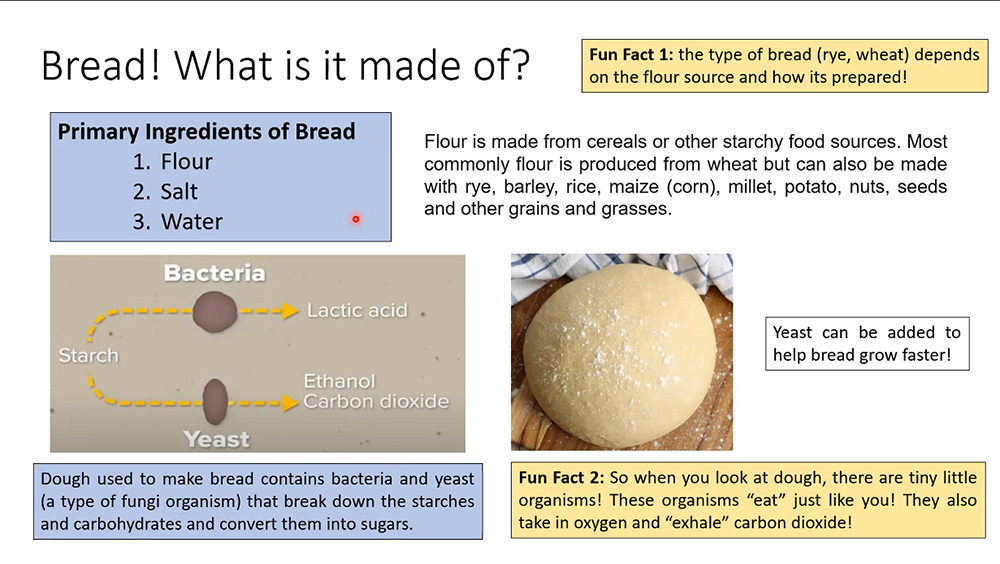
ENVISION students' slide about bread making.













.jpg)
















